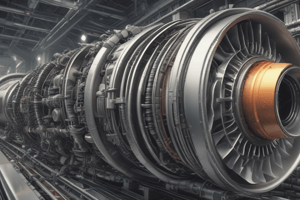Podcast
Questions and Answers
Which components of the flue gas are measured in a combustion gas analysis?
Which components of the flue gas are measured in a combustion gas analysis?
- Nitrogen (N0^)
- Airborne pollutants
- Oxygen (Oy), carbon monoxide (CO), and carbon dioxide (COy) (correct)
- Particulates, SO-^, and mercury
What is the primary purpose of a flue gas analysis?
What is the primary purpose of a flue gas analysis?
- To measure the components emitted to atmosphere
- To determine the individual components of the gas
- To monitor stack emissions
- To analyze the efficiency and completeness of the combustion process (correct)
What unit is commonly used to measure smaller concentrations, such as airborne pollutants, in flue gas analysis?
What unit is commonly used to measure smaller concentrations, such as airborne pollutants, in flue gas analysis?
- Kilogram
- Mole
- Parts per million (ppm) (correct)
- Percent volume
Which gas is the product of complete combustion?
Which gas is the product of complete combustion?
What does the presence of carbon monoxide (CO) in the flue gas indicate?
What does the presence of carbon monoxide (CO) in the flue gas indicate?
What is the reading in percent by volume for a flue gas sample containing 500 ppm NO2?
What is the reading in percent by volume for a flue gas sample containing 500 ppm NO2?
What is the reading in parts per million (ppm) for a flue gas sample containing 0.02% NO2?
What is the reading in parts per million (ppm) for a flue gas sample containing 0.02% NO2?
According to the information provided, what is the trend observed in Table 13 regarding the flue gas CO2 and O2 percentages as the excess air increases?
According to the information provided, what is the trend observed in Table 13 regarding the flue gas CO2 and O2 percentages as the excess air increases?
Based on the given data, what are the CO2 and O2 percentages by volume for a coal-fired plant with excess air calculated at 60%?
Based on the given data, what are the CO2 and O2 percentages by volume for a coal-fired plant with excess air calculated at 60%?
According to the formulas provided, how is the theoretical (stoichiometric) air required to burn fuel calculated?
According to the formulas provided, how is the theoretical (stoichiometric) air required to burn fuel calculated?
Based on the given data, what is the percent of excess air used in the coal-fired boiler that uses coal with an analysis by mass of C = 78%, N2 = 6%, O2 = 3%, and non-combustibles = 13%, and a flue gas sample with the following volume analysis: O2 = 7.8%, CO = 0.2%, 002 = 10.4%, and N2 = 81.6%?
Based on the given data, what is the percent of excess air used in the coal-fired boiler that uses coal with an analysis by mass of C = 78%, N2 = 6%, O2 = 3%, and non-combustibles = 13%, and a flue gas sample with the following volume analysis: O2 = 7.8%, CO = 0.2%, 002 = 10.4%, and N2 = 81.6%?
Flashcards are hidden until you start studying



